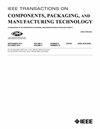Analysis of Bondwires and RF Compensation Circuits in E-Band
IF 3
3区 工程技术
Q2 ENGINEERING, ELECTRICAL & ELECTRONIC
IEEE Transactions on Components, Packaging and Manufacturing Technology
Pub Date : 2025-07-31
DOI:10.1109/TCPMT.2025.3594505
引用次数: 0
Abstract
This article investigates the impact of bondwire interconnections on signal integrity in low and high millimeter-wave (mmWave) applications, emphasizing transmission degradation caused by inductive and parasitic effects. Through detailed measurements and analysis, we demonstrate that transmission loss and impedance mismatches can be effectively reduced by minimizing bondwire length and using multiple wires in parallel. Based on empirical data, we developed an electrical model of bondwire incorporating distributed inductance, capacitance, resistancee波段键合线及射频补偿电路分析
本文研究了低毫米波和高毫米波应用中键合线互连对信号完整性的影响,强调了由电感和寄生效应引起的传输退化。通过详细的测量和分析,我们证明了通过最小化键合线长度和使用多根线并联可以有效地减少传输损耗和阻抗不匹配。基于经验数据,我们建立了结合分布电感、电容、电阻(L/C/R)和传输线特性的键合线电学模型。为了进一步提高性能,我们引入了紧凑的补偿电路,采用LC结构和径向桩,针对单键合线和双键合线配置进行了优化。实验验证表明,所提出的双线LC补偿技术显著降低了插入损耗(从5到1.5 dB),并提供了70到75 GHz的回波损耗带宽。这项工作的关键新颖之处在于将多个键合线与低复杂性,紧凑的LC补偿结构集成在一起,为降低插入损耗和改善毫米波系统中的阻抗匹配提供了有效的解决方案。这种方法为改善毫米波系统中的芯片对板和板对板互连性能提供了一种实用且可扩展的解决方案。
本文章由计算机程序翻译,如有差异,请以英文原文为准。
求助全文
约1分钟内获得全文
求助全文
来源期刊

IEEE Transactions on Components, Packaging and Manufacturing Technology
ENGINEERING, MANUFACTURING-ENGINEERING, ELECTRICAL & ELECTRONIC
CiteScore
4.70
自引率
13.60%
发文量
203
审稿时长
3 months
期刊介绍:
IEEE Transactions on Components, Packaging, and Manufacturing Technology publishes research and application articles on modeling, design, building blocks, technical infrastructure, and analysis underpinning electronic, photonic and MEMS packaging, in addition to new developments in passive components, electrical contacts and connectors, thermal management, and device reliability; as well as the manufacture of electronics parts and assemblies, with broad coverage of design, factory modeling, assembly methods, quality, product robustness, and design-for-environment.
 求助内容:
求助内容: 应助结果提醒方式:
应助结果提醒方式:


